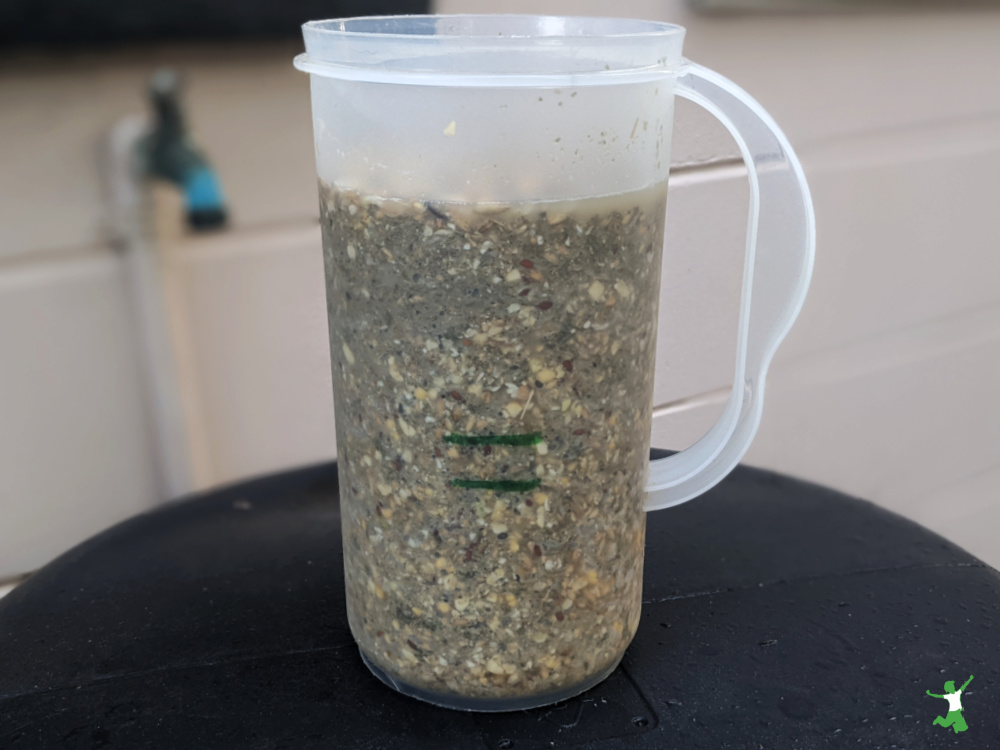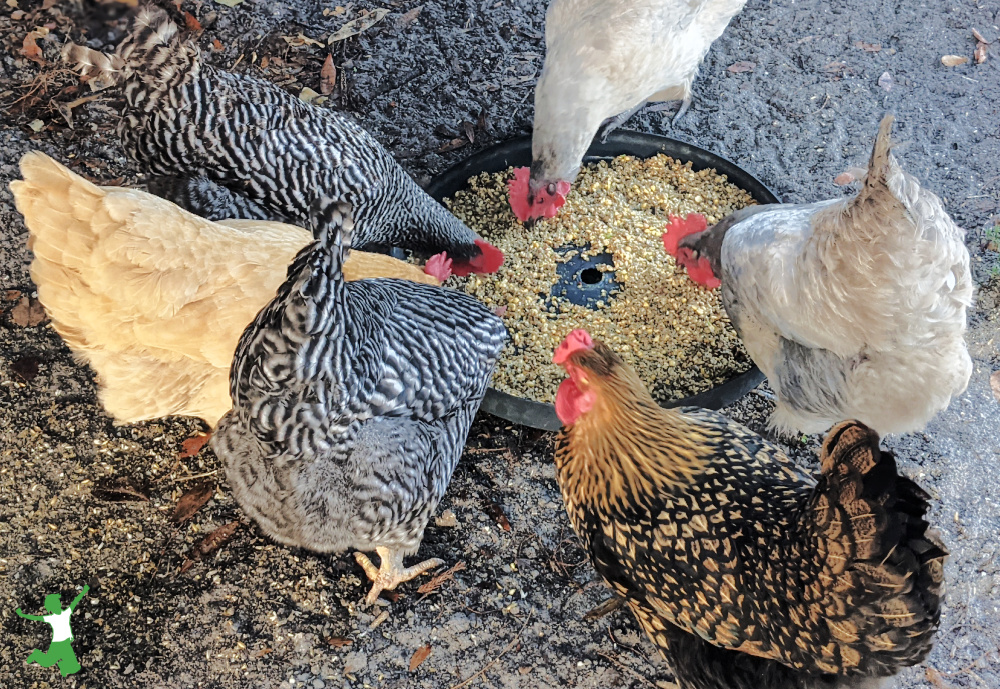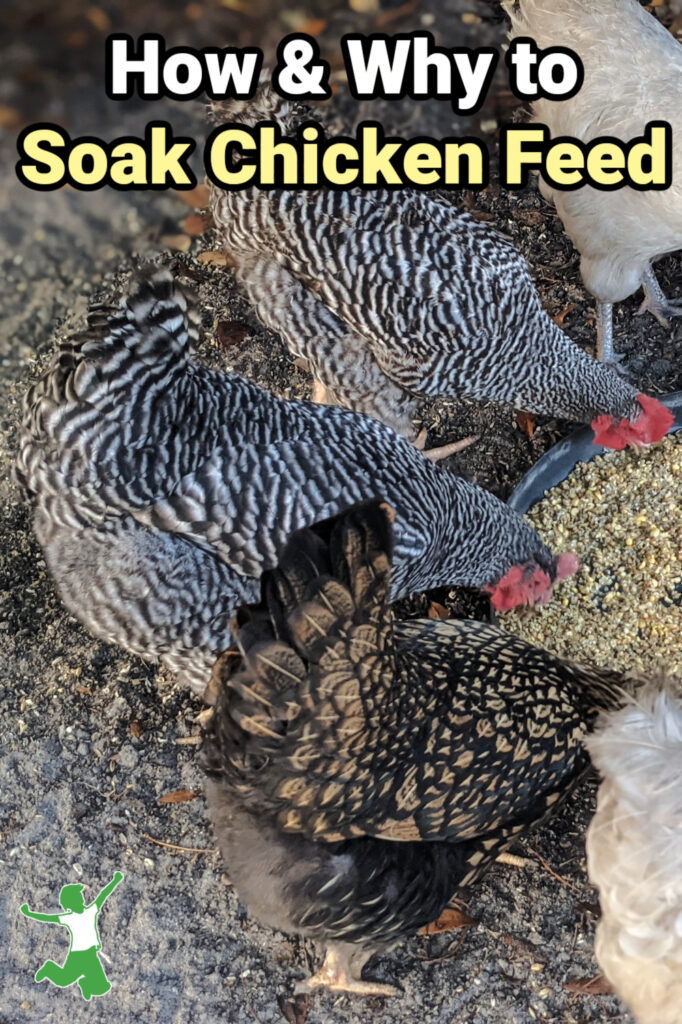
Table of Contents[Hide][Show]
How to soak chicken feed for better health and production from your backyard hens and an important security check against toxic feed that might stop them from laying.

There’s a lot of buzz in the alternative news of late that certain brands of commercial chicken feed are stopping hens from laying.
While mainstream media is predictably scrambling to discredit the stories from citizen journalists, the dozens of videos on social media showing the before and after results of homestead egg production once tainted feed is replaced with freshly milled versions is quite convincing! (1)
These stories are certainly worrisome especially against the backdrop of numerous egg facilities mysteriously burning down and egg prices more than doubling. (2, 3)
Why Start Soaking Your Chicken Feed?
There is a simple solution for those of us that keep a small flock of hens to provide our families with excellent quality eggs and a measure of food security.
Soak your chicken feed overnight!
I find soaking the feed for 8-12 hours or overnight to be the easiest method compared with fermenting for several days.
You get all the benefits listed below without the additional time required.
More on that later.
Soaked vs Wet Feed
Before I go over the benefits of soaking your chicken feed, I want to clarify that soaking is not the same as wetting it.
Wetting feed simply means adding water to it before giving it to the chickens.
Wet feed does not show any benefits to the chickens compared with dry or fermented feed and may actually reduce their heat tolerance. (4)
Soaking feed is similar to what you would do with a pot of overnight oats for yourself.
You add filtered water and give the mixture enough time to begin the process of fermentation.
Never use chlorinated tap water for soaking feed.
This chemical will threaten the viability of the naturally occurring friendly bacteria present in the feed. Soaking encourages its proliferation to the benefit of your chicken’s health.
While some people leave the wet mixture for 2 days or longer, I only soak it overnight to reduce the chances of mold since I live in an environment that is quite humid for most of the year.
Even with an overnight soak, the chicken feed definitely starts to ferment. In the morning, I notice slight bubbling at the surface of the mixture. This indicates probiotic activity.
If you live in a dry environment and wish to ferment the soaked feed for longer, I recommend having two or at most three soaking containers. The first is for “day 1” soaked feed, another for “day 2”, and so forth.
Next, let’s go over the benefits of soaking feed overnight for your backyard chickens!
More Nutritious Eggs
Research shows that fermented feed for laying hens provides them with more digestible nutrition which translates into better eggs.
In a study of nearly 500 pullets, those that dined on fermented feed gained more weight.
They also laid heavier eggs with harder shells..indicative of better overall quality…than adolescent hens fed non-fermented commercial chicken feed. (5)
Better Health
Soaking chicken feed overnight to allow the probiotics to begin to flourish also has benefits on the health of the hens.
They have a more acidic upper digestive tract which is protective against pathogens like E. coli, Salmonella, and Campylobacter. (6)
Reduced Feed Cost
With chicken feed prices increasing, it is good to know that taking the small amount of time required to lightly ferment the feed by soaking it overnight in filtered water will reduce the amount of food the hens eat. (7)
The same thing happens to us! Whether you are soaking oatmeal overnight or soaking flour for pancakes, the result will be that you eat less because you get full faster.
Thus, this small investment of time will serve to reduce your feed costs and save you some money!
Tests that Feed is Safe
With reports of tainted feed circulating social media, perhaps the best aspect of soaking your chicken feed before feeding it to your hens is that it is a test of its safety.
In the video below, a woman who soaks her chicken feed shows how the tainted feed that stopped her chickens from laying does not absorb water, unlike freshly milled feed and untainted pellets.
How to Soak Chicken Feed
Now that we’ve established that soaking chicken feed at least overnight is a good idea, let’s discuss the how-to.
Type of Feed to Soak
While you can soak any type of chicken feed whether it be crumbles, pellets, or freshly milled, I suggest freshly milled as the best.
There are two brands I’ve consistently used over the past decade that are excellent:
If you prefer pellets, I suggest Modesto Milling organic and soy-free layer pellets as the best value.
I’m sure there are other good brands to use. These are just the three I’ve tried over the years and been consistently happy with.
Mix Feed with Water
Once you have a good feed ready to go, place the right amount for the size of your flock in a sturdy container.
Each chicken will eat about 4-5 ounces of feed per day. (9, 10)
To avoid the hassle of measuring the correct amount every day, I simply marked a container with the appropriate fill line. You can see this in the picture at the top of the article.
The first line is for the 24 ounces, or 4 ounces of feed for 6 chickens (the size of my flock). The second line indicates where to fill the container with 30 ounces or 5 ounces of feed per chicken.
Depending on how much the hens are eating (they eat more at certain times of the year), I will fill the container to either the first or second line.
Then, I fill the container with filtered spring water about 2 inches above the top of the feed.
While you can stir the feed and water if you want to, it’s not necessary.
What if You Forget to Soak the Feed?
Note that if you forget to soak your feed before bed, no worries.
Just feed the chickens dry feed the next day.
Wetting it in the morning and giving it to them without at least 8-12 hours of soaking has no benefits and can actually be detrimental in hot weather.
Let Mixture Sit Overnight
After adding the water to the feed, I place a sturdy cover over the top and leave it on the kitchen table overnight.
The lid does not need to be tight-fitting.
The next morning, you will notice that the excess water has been completely absorbed and the feed size per grain has swelled significantly.
The picture at the top of the article shows how much the feed expands in volume overnight!
I also consistently notice a few bubbles percolating at the top of the mixture indicating probiotic activity.
Your soaked feed is ready to use!
Pour Soaked Feed into Shallow Container
The next step is to feed your chickens with the soaked, lightly fermented mixture.
I pour the feed into a shallow container and place it on the ground in the free-ranging area.
Take care to place it in a spot that is protected overhead from dive-bombing chicken hawks.
We use an old trampoline as a large “hawk cover” in our main chicken run.
This is where I place the food, so they can eat in complete safety.

Rinse and Repeat
At dusk when the chickens go back into the coop to roost for the night, I take the shallow container and rinse it with a hose and set it aside to use the next morning with my next batch of soaked feed.
That’s all there is to it!
I think you will find that by taking the few minutes required to soak your chicken feed overnight, you will observe a healthier flock that eats less and produces sturdier eggs.
You can also rest easy knowing that the feed is not tainted because it properly absorbs water and starts to ferment with probiotics. This would likely not happen with feed that was impure or unsafe in any way.

(1) Chicken Farmers Blame Tainted Feed After Hens Stop Producing Eggs
(2) Who Is Burning Down America’s Food Processing Plants?
(3) Egg Prices Have Nearly Doubled. Why Are Egg Prices So High?
(4) Effect of Feeding Wet Feed or Wet Feed Fermented by Bacillus licheniformis on Growth Performance, Histopathology and Growth and Lipid Metabolism Marker Genes in Broiler Chickens
(5, 6, 7) Fermented feed for laying hens: effects on egg production, egg quality, plumage condition and composition and activity of the intestinal microflora
(8) Toxic chicken feed does not expand when soaked
(9) Chicken Feed per Layer per Day
(10) How Much Layer Pellets Per Day?
(11) Should I Ferment or Soak my Chicken Feed?